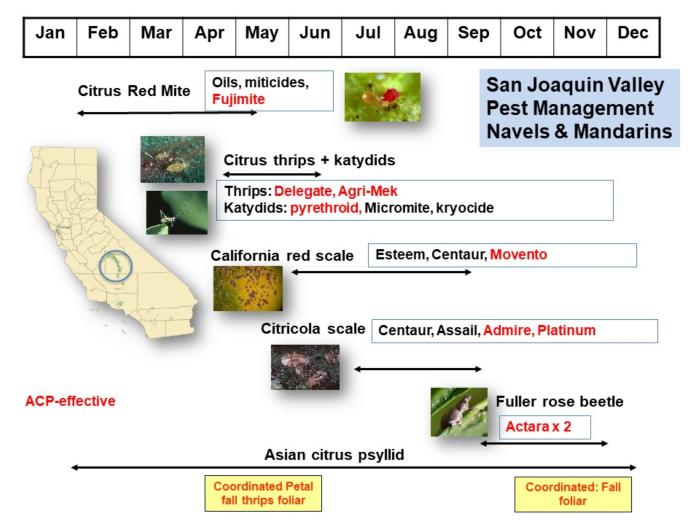San Joaquin Valley
The strategy for all regions is to minimize the number of extra pesticide treatments applied for ACP in order to preserve IPM programs for other pests and reduce the risk of resistance developing.
San Joaquin Valley ACP eradication program: ACP is not well-established in the San Joaquin Valley. Most psyllids are found in low numbers on trap cards and only occasionally infesting a tree. When aggressive treatments are applied, the psyllid can be locally eradicated for a period of time. The treatment program for this region consists of a coordinated application of two insecticides to both commercial citrus (800 meters around a find) and residential citrus (400 meters around a find). The preferred treatments are a pyrethroid and imidacloprid (see eradicative treatments). Whenever treating for other pests, choose a pesticide that will also control ACP. For example, the Fujimite, Delegate, Exirel, pyrethroids, Lorsban, Platinum, Actara, Sivanto and Movento treatments (shown in red) applied for common pests would assist with ACP control.
Special Notes for San Joaquin Valley Growers
- The goal is to locally eradicate the psyllids wherever they are found
- Urban areas can be a source of psyllids for groves and are treated by CDFA whenever psyllids are found.
- If there are repeat finds near each other in an area of contiguous citrus, then a group of growers (neighboring psyllid management areas or PMAs) will be asked by the SJV Task Force to voluntarily treat during a 2-3 week window with an ACP-effective insecticide to achieve a coordinated treatment over an area much larger than 800 meters. Thus far, these coordinated treatments have been timed for periods when growers normally treat for citrus thrips or Fuller rose beetle.
Common Treatments for San Joaquin Valley Citrus Pests

